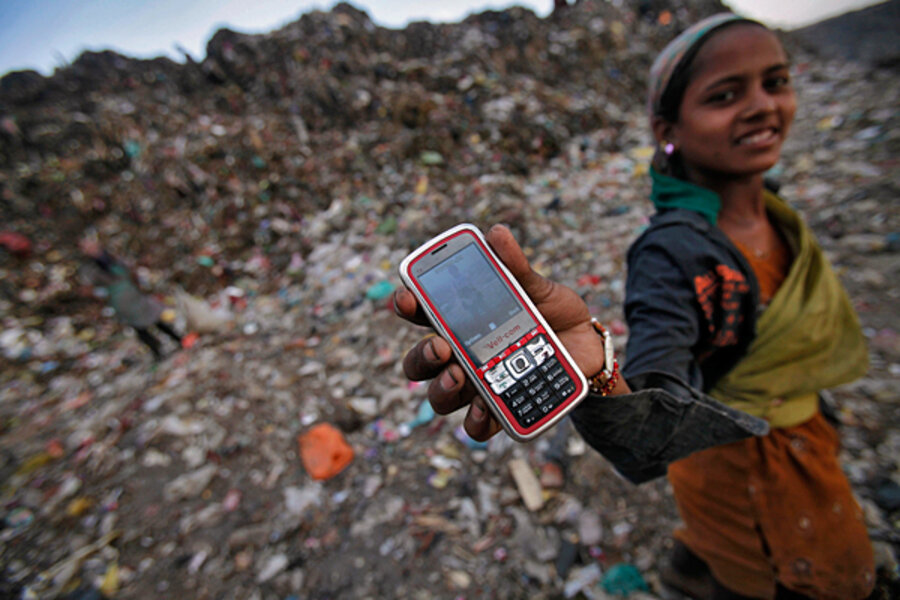Developing countries lead the way in deploying mobile technology
Loading...
From remote farms to rural health centers, one thing is transforming how even the world's poorest people live: the mobile phone.
Cellphone use in the developing world has climbed to nearly 5 billion mobile subscriptions, and three-quarters of the world now has access to mobile networks. This technology is reshaping the way individuals and communities manage their finances, monitor weather, engage with government, and earn a living, according to the recent World Bank Maximizing Mobile report.
“People are going from zero to 60. It is huge to go from no phone at all to a cellphone,” says Anne Nelson, international media development specialist and adjunct professor at Columbia University. “The rapid penetration of cellphones in developing countries is changing lives dramatically.”
Mobile devices in regions like Africa are largely limited to voice and Short Message Service texting, but even the most basic mobile communications can increase school attendance, facilitate banking or cash transfers, create jobs, measure health indicators, accelerate disaster response, and fuel citizen engagement in governance and democracy.
For example, in Niger, access to cellphones has allowed grain traders to compare market prices across the country, cutting the cost of traveling to different markets and resulting in profit improvements of nearly 30 percent for traders. In Kenya, a program sent text messages to rural patients with AIDS, reminding them to take their antiretroviral drugs. It was found that sending these messages was not only more affordable than in-person reminders, but those receiving SMS messages showed higher rates of taking their meds than those who did not receive them.
Mobile technology has also been lauded in the recent democratic uprisings in the Middle East. In Egypt, only about 10 percent of the population had landlines a decade ago, leaving much of the population without any phone access at all. Today, there are 82 million mobile phones in circulation, and the numbers are constantly growing.
The phones were “game changers” during the Arab uprisings, not necessarily because of Twitter or Facebook – many cellphones in Egypt, as in many rural parts of the developing world, don't have broadband access. Instead, “for the first time, people were able to call or text each other and say ‘Hey, let’s meet and go down to the square.’ That wasn’t possible before,” says Ms. Nelson.
Despite the implications for easing poverty, the motivation for purchasing a mobile device is not necessarily linked to improved social services. Many people buy mobile phones to stay connected to friends and family, or for entertainment purposes, Nelson says. But connectivity has become such a priority that in Asia, South America, and Africa some people spend between 5 and 15 percent of their disposable income on telecommunications services, according to a 2010 study by Ericsson. Other experts estimate investment in cellular technology can reach up to 30 percent of income.
According to the World Bank, as phones become cheaper and more robust and networks double their bandwidth almost every year and a half, more people have access to mobile devices than they do clean drinking water or electricity in some countries.
However, “technology won’t create development instruments by itself,” says Nelson. And both multinational institutions and international development agencies are acknowledging this: As of 2011, nearly 75 percent of all World Bank investment lending projects had an Information and Communication Technology component, and more than $4 billion was invested in the ICT sector between 2003 and 2010.
International organizations are increasingly partnering with the private sector to improve new technology, create sustainable ICT-based programming, and design relevant mobile applications. As with all development work, acknowledging unique factors across different cultures – such as gender breakdown of mobile-phone ownership – is paramount in creating successful initiatives. A mobile application designed to ease reporting on violence against women will likely fall short if men are the primary users of mobile devices in the target community.
The “mobile revolution” is still in its beginning stages.
“The challenge now is to enable people, businesses, and governments in developing countries to develop their own locally relevant mobile applications so they can take full advantage of these opportunities,” said Rachel Kyte, vice president for sustainable development at the World Bank.
Already many mobile innovations, including low-cost recharges and mobile payments, originate in poorer countries and spread from there. As developing countries continue to play a leading role in mobile-device subscription and innovation, the development of mobile applications targeted at rural communities with limited access to health services or banking could gain a broader international reach. And as some applications gain success and are tweaked and replicated, their presence in developed countries could multiply as well.








